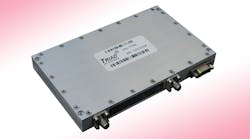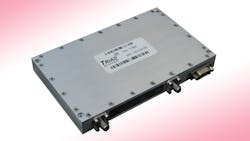The TTRM1008 high-linearity GaAs FET bidirectional solid-state power amplifier (SSPA) is suitable for use with any type of modulation and signal. It’s commonly used in unmanned-aerial-vehicle (UAV) data links and long-range point-to-point coded-orthogonal-frequency-division-multiplex (COFDM) video links, and developed initially for applications from 4.4 to 5.0 GHz.
An on-board complex programmable logic device (CPLD) on the model TTRM1008 coordinates high-speed transmit/receive (T/R) switching and sequencing of the unit’s power amplifier (PA), low-noise amplifier (LNA), and switch driver circuitry. As a result, the timing of switching functions can be adjusted in firmware based on system requirements.
The compact unit’s transmit section produces over 25 W of binary-phase-shift-keying (BPSK) power, with more than 5 W of 64-state quadrature-amplitude-modulation (64QAM) output power. The unit also features a manual digital gain setting and a three-color status light-emitting diode (LED) on the front panel that shows if the SSPA is in transmit or receive mode, or if there’s an alarm condition. The amplifier housing is weatherproofed per the guidelines of IP66. The unit can also be specified for other frequency bands, including 5.0 to 5.3 GHz and 5.3 to 5.9 GHz.
Triad RF Systems Inc., 180 Tices Lane, Building A, Suite 107, East Brunswick, NJ 08816; E-mail: [email protected]

